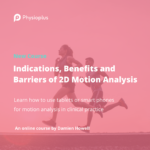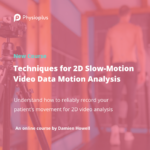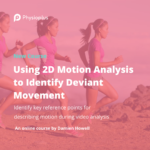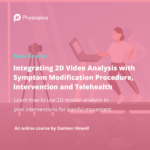Read more about the benefit of 2D Video Gait Analysis in a blog Damien wrote for Physiospot.
If pain occurs with movement, then observation and analysis of movement are required. In our brand new programme of courses you will learn how to utilise smartphone video slow motion analysis to identify abnormal movement.
Real-time symptom modification of deviant movement can improve the effectiveness and efficiency of movement system impairment syndromes. This approach can be fun by providing significant individual case level evidence, enhanced patient-centred care while enhancing engagement with the client to solve their movement problems.
The use of 2D motion analysis can enhance clinicians’ existing clinical toolkit and facilitate reflective learning and the professional development of the clinician.
Instructor
 Damien Howell promotes evidence-based, patient-centred, effective, and efficient Physical Therapy services
Damien Howell promotes evidence-based, patient-centred, effective, and efficient Physical Therapy services
Damien has decades of experience as an educator, in clinical education and continuing education teaching, along with previous academic positions at Indiana University and Virginia Commonwealth University. Damien’s graduate studies were at the University of Pennsylvania; Virginia Commonwealth University; and Washington University St. Louis. Damien is an active physical therapy clinician eager to share what he has learned from his extensive clinical experience. He continues to provide inspiration and mentoring to peers to promote evidence-based, patient-centred, effective, and efficient Physical Therapy services.
The Courses
Overview and Introduction to Women’s Pelvic Health

The observation, analysis and management of movement are necessary to address movement system impairments. While the use of 2D slow-motion video can facilitate this process, this technique is under-utilised. This course, the first in a four-part series, provides a guide to the indications, benefits and barriers related to the use of 2D motion analysis. The course aims to describe the indications for, benefits of, and barriers to the use of 2D slow-motion video analysis in clinical practice.
Use a Phone To Transform Your Practice
Techniques for 2D Slow-Motion Video Data Motion Analysis

The analysis of human movement is of great interest for performance, injury prevention and optimal recovery from injury or trauma. Movement analysis is also a key component of the physiotherapy evaluation. The emphasis on evidence-based practice in physiotherapy stresses the need for standardised outcome measures when evaluating patients. Videography with its related technology has been used since its inception to examine various functional limitations resulting from impaired movements, as well as a means for visual feedback. With developments in technology, more cost-effective solutions are available for assessing human movement and two-dimensional (2D) imaging has become an easily accessible and cost-effective alternative to costly 3D systems. This lecture will explore the tactics and techniques used for recording, analysing, storing and retrieving video data in 2D slow-motion video analysis.
Master The Techniques Required to Use 2D Video Analysis
Using 2D Motion Analysis to Identify Deviant Movement

Over the past decade, there has been a growing demand for precise and accurate methods to assess human movement. Analysing human movement and posture allows clinicians to observe movement execution and identify injury risk factors in order to make the best decisions to reduce the patient’s recovery time and implement effective treatment plans. Using key reference points enables the clinician to accurately describe, communicate and analyse the observed motion of the patient. This lecture will clarify some commonly used terms associated with movement deviation and identify frequently used reference points for describing motion.
Identify Key Reference Points During Analysis
Integrating 2D Video Analysis with Symptom Modification Procedure, Intervention and Telehealth

Observing and analysing movement is important when managing movement system impairment syndromes. When deciding whether or not to use 2D slow-motion video analysis to facilitate this process, it is essential to consider a number of related issues, including potential indications for and benefits of this practice, possible barriers to its implementation, techniques for capturing the video and conducting the analysis, and specifics regarding the identification of atypical or deviant movement. Finally, the provider needs to determine how best to apply the information learnt through this analysis. This course is designed to assist the provider in learning how to integrate the 2D motion analysis with symptom modification procedures, both face-to-face and via telehealth.
Use 2D Gait Analysis To Create a Treatment Plan
 Damien Howell promotes evidence-based, patient-centred, effective, and efficient Physical Therapy services
Damien Howell promotes evidence-based, patient-centred, effective, and efficient Physical Therapy services


